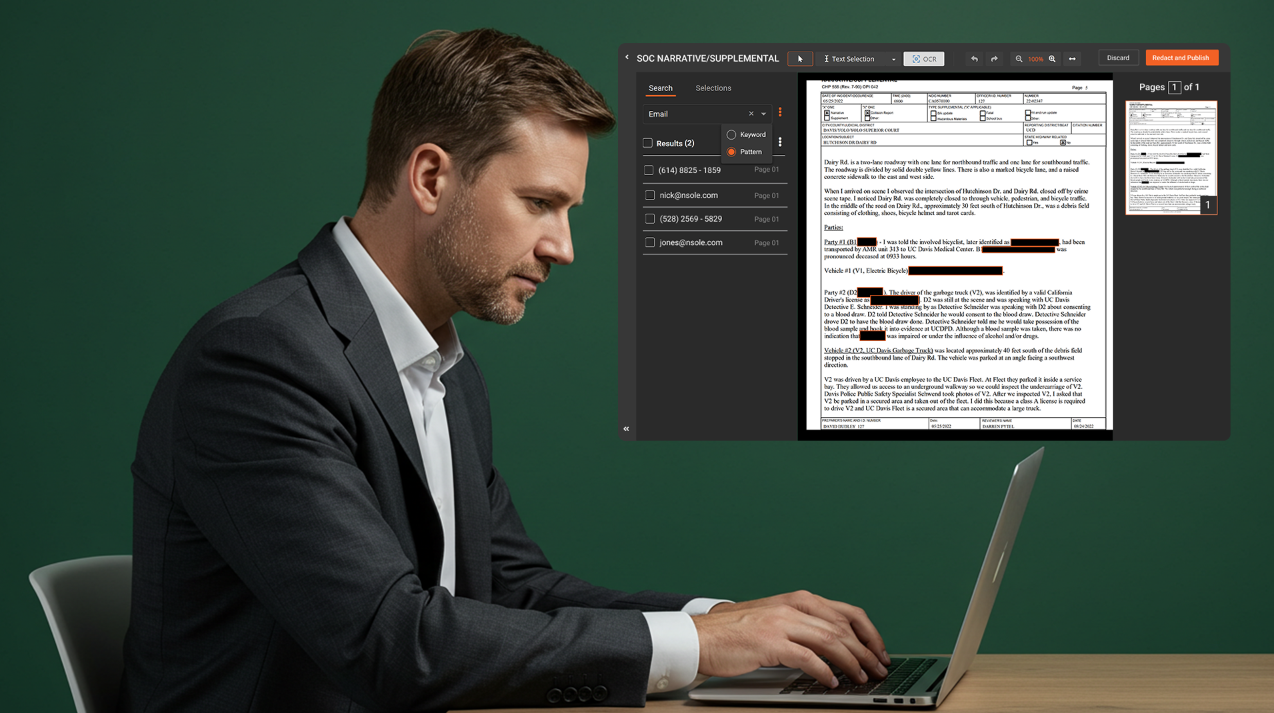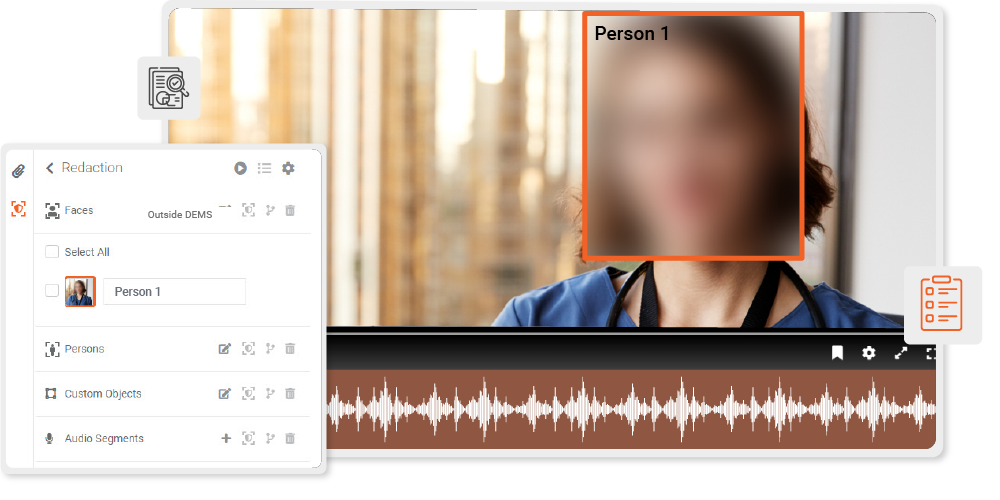How AI Redaction Software Helps Under-Resourced Law Enforcement Agencies
by Moazzam Iqbal, Last updated: April 7, 2025, Code:

Imagine you’re tasked with leading a department where expectations keep rising, but budgets remain stagnant. Crime doesn’t stop, and investigations keep moving.
However, your officers are burdened with the slow and time-consuming task of redacting bodycam, dashcam, and surveillance footage, diverting valuable time from critical law enforcement responsibilities.
Manual redaction is not only time-consuming but also diverts valuable officers from operational duties, preventing them from focusing on their most critical responsibilities. Missing even a single frame can lead to legal trouble, delays can put cases at risk, and every extra hour spent on redaction drains your department’s efficiency.
How much longer can your team keep up this pace before something important gets overlooked?
In fact, federal agencies are generating more video content than ever before, including vast amounts of body camera footage and surveillance videos, significantly increasing the administrative burden on law enforcement agencies. This growing demand is reflected in the sharp rise in FOIA requests.
In fiscal year 2023 alone, federal agencies received a record 1.1 million FOIA requests—a 29% increase from the previous year. The Department of Homeland Security (DHS), which plays a key role in law enforcement, handled the highest volume, processing over 450,000 requests.
This is the reality for many law enforcement agencies struggling with limited resources. While crime-fighting remains the top priority, administrative burdens—such as FOIA redaction across videos, images, audio, and documents—consume valuable time, budgets, and personnel.
Want to see how your state is impacted? Visit our detailed, state-specific overview of rising FOIA requests, penalties for non-compliance, criminal caseload, and more, and learn how your law enforcement agency can combat it.
Why Manual Redaction is Failing: The Need for Law Enforcement AI Redaction Software
For FOIA Officers, the rapid growth of digital evidence from body-worn cameras, dashcams, surveillance systems, and smartphones is more than an operational challenge—it’s a resource nightmare.
Each piece of footage must go through meticulous redaction to remove personally identifiable information (PII) before sharing it with courts, the public, or other agencies. Beyond protecting privacy, redaction is crucial for upholding public trust and ensuring legal compliance.
Records and Evidence Managers also face the burden of manual redaction, which often means scrubbing through footage frame by frame. Officers spend hours blurring faces, masking license plates, and redacting audio—tasks that pull them away from active law enforcement duties. Meanwhile, administrative staff struggle to keep up.
As the backlog grows, deadlines loom, and the risk of errors increases. However, law enforcement AI redaction software offers a smarter solution. It automates time-consuming tasks, reduces errors, and helps agencies stay compliant, freeing up valuable resources for critical law enforcement operations.
Budget Constraints Are the New Normal
For police departments with tight budgets, financial constraints are more than just numbers—they impact operational efficiency and officer well-being. Meanwhile, digital evidence continues to grow, but law enforcement budgets aren’t keeping pace.
Hiring more staff isn’t always an option. Yet, the workload keeps increasing, creating a gap that manual redaction simply can’t bridge. This is where police video redaction software provides a cost-effective solution.
Law enforcement agencies must manage increasing volumes of digital evidence while ensuring data security and efficiency. However, relying on manual processes and additional manpower is no longer sustainable. With limited resources and growing compliance demands, AI-powered redaction software is the key to faster, more efficient redactions.
Compliance Pressures Keep Mounting
Legal Advisors and Prosecutors understand that compliance isn’t optional. Law enforcement agencies must follow strict data privacy regulations, including FOIA, CJIS, and GDPR. A single oversight—like an unblurred face or exposed license plate—can result in lawsuits, fines, and public distrust. The stakes are high, and the margin for error is razor-thin.
Public Information Officers responsible for handling FOIA requests face constant deadlines and legal obligations. However, manual redaction slows response times and increases the risk of accidental disclosures, putting agencies at legal and reputational risk.
By adopting redaction software for law enforcement, agencies can streamline compliance, reduce errors, and more efficiently protect sensitive information.
What is AI-Powered Redaction Software?
AI-powered redaction software is redaction software that uses the power of AI to automatically detect, track, and redact sensitive information within digital content, including videos, audio recordings, documents, and images.
This includes the automated detection and masking of faces, license plates, and personally identifiable information (PII). Using PII redaction software, law enforcement agencies can efficiently redact sensitive data while ensuring compliance with privacy regulations and legal mandates.
How AI-Powered Redaction Software Differs from Traditional Redaction Tools
Traditional redaction tools depend on manual intervention, making the process slow and error-prone. As a result, agencies struggle with inconsistent redactions and inefficient workflows.
In contrast, AI redaction solutions continuously learn and improve through data exposure. This adaptability enhances accuracy, speeds up processing, and reduces human error.
Moreover, AI-driven tools minimize the risk of oversight by automating detection and redaction. As a result, law enforcement agencies can process digital evidence faster, more accurately, and more efficiently.
How Law Enforcement AI Redaction Software Operates
Law enforcement AI redaction software is designed to address these exact pain points. It doesn’t just make redaction faster; it makes it smarter, more accurate, and resource-efficient.
Key Features of Law Enforcement AI Redaction Software
AI redaction software is designed to tackle law enforcement agencies' unique challenges. It offers advanced features that streamline redaction, enhance efficiency, and ensure compliance when handling sensitive information.
Moreover, these tools improve accuracy by automating the detection and redaction of personally identifiable information (PII) in videos, images, audio, and documents.
Object Detection
Advanced AI object detection automatically identifies sensitive information in videos and images, transforming the redaction process for law enforcement agencies.

This technology applies to various types of law enforcement footage, including:
- Body-worn camera videos
- Dashcam recordings
- Public surveillance footage
- Interview room recordings
- Crime scene photos
By scanning these files, AI detects and redacts sensitive objects such as faces, license plates, vehicles, and weapons. As a result, agencies can quickly and efficiently protect sensitive information while ensuring compliance with legal standards.
How It Solves Law Enforcement Challenges
Object detection in AI-powered redaction software helps law enforcement with the following benefits:
- Enhances Efficiency: No more scrubbing through endless footage frame by frame. The AI handles detection in seconds, allowing officers to focus on critical tasks.
- Ensures Compliance: Meets stringent industry regulations and legal requirements, meticulously redacting sensitive details to reduce the risk of data breaches and legal liabilities.
- Reduces Errors: The precision of object detection minimizes the chances of overlooking sensitive information, ensuring unwavering privacy.
- Improves Accuracy: AI-powered tracking reduces the risk of missing sensitive information as the object moves in and out of the scenes, ensuring consistent coverage.
- Minimizes Human Errors: Manual redaction can lead to overlooked frames, but object tracking automates the process, minimizing the risk of human oversight.
- Customizable Tracking: Officers can define the specific objects to track, set the tracking duration, and even adjust sensitivity settings to align with the nature of the footage.
For law enforcement agencies dealing with extensive video evidence, object tracking helps streamline redaction, ensuring sensitive information is consistently protected without overwhelming administrative resources.
Optical Character Recognition (OCR)
Optical Character Recognition (OCR) is an advanced AI-driven technology that identifies and extracts text from scanned documents, printed forms, and images. It enables law enforcement agencies to quickly detect and redact sensitive information, ensuring data security and compliance with legal mandates.

OCR Redaction for Law Enforcement Documents
OCR applies to various types of scanned documents, including:
- Incident reports
- Witness statements
- Arrest records
- Identification documents (driver’s licenses, passports)
- Court documents
- Forensic reports
By automating text recognition, OCR helps efficiently identify and redact sensitive information, such as:
- Personal identifiers (names, addresses, Social Security numbers)
- Case details
- License plate numbers
- Confidential records
How OCR Redaction Works
OCR scans and analyzes documents to recognize and extract text. As a result, agencies can quickly identify and redact sensitive data while maintaining compliance with FOIA, CJIS, and GDPR.
By using document redaction tools, law enforcement can reduce manual effort, improve accuracy, and streamline redaction processes for large volumes of digital evidence.
How It Solves Law Enforcement Challenges
The following are the challenges solved by Optical Character Recognition (OCR) in AI-powered redaction software:
- Redact Scanned Documents: OCR can detect and redact sensitive information from scanned documents. This eliminates the need for manual review, saving significant time.
- Efficient Redaction Process: While OCR simplifies identifying sensitive information in large volumes of documents, redaction is performed individually, ensuring accuracy and precision in each case. This helps reduce administrative workload and supports efficient case processing.
- Detect Text in Documents: OCR technology enables the identification and redacting of sensitive text within documents, ensuring compliance and data privacy.
- Advanced Search Functionality: OCR technology allows users to search within documents and images using text-based queries. This helps law enforcement professionals quickly locate files containing specific information, enhancing investigative efficiency.
OCR technology significantly improves operational efficiency by automating the detection and redaction of sensitive text. Moreover, it reduces the risk of human error, ensuring that confidential information remains secure.
As a result, law enforcement agencies can process large volumes of documents faster, maintain compliance with FOIA and data privacy regulations, and enhance overall investigative accuracy.
Spoken PII Redaction
Spoken PII redaction Software is an AI-powered capability that identifies and removes personally identifiable information (PII) from audio and video content. This feature is essential for law enforcement agencies handling sensitive recordings that need to comply with privacy regulations.

Examples of sensitive recordings in law enforcement include:
- Body-worn camera footage from patrol officers
- Dashcam recordings during traffic stops
- Interview room recordings with witnesses or suspects
- 911 emergency call recordings
- Surveillance audio from covert operations
- Court proceedings
Audio redaction software automatically scans audio tracks within videos or standalone audio files to detect spoken PII such as:
- Names
- Addresses
- Social Security numbers
- Phone numbers
As a result, law enforcement agencies can quickly and accurately redact sensitive audio content, ensuring compliance with privacy laws and maintaining data security.
How It Solves Law Enforcement Challenges
AI-powered PII Redaction software helps law enforcement agencies overcome several key challenges when handling sensitive audio recordings:
- Auto-Redact Spoken PII: Automatically identifies and redacts sensitive spoken information without manual intervention, ensuring no detail is missed.
- Regulatory Compliance: Supports compliance with legal requirements like FOIA (Freedom of Information Act), CJIS (Criminal Justice Information Services) standards, and other law enforcement-specific data privacy regulations, reducing the risk of data breaches.
- Content Integrity: Offers options like muting or bleeping the redacted portions, preserving the overall context of the content while safeguarding sensitive information.
- Efficiency: Reduces the need for manual review of lengthy recordings, saving time and resources for law enforcement personnel.
This feature is especially valuable for bodycam footage, interview recordings, and emergency call audio, where protecting sensitive spoken information is crucial.
By automatic redaction, AI-powered tools ensure that names, addresses, and other personally identifiable information (PII) are accurately removed, helping law enforcement agencies maintain compliance and safeguard privacy.
Confidence Scores
Confidence scores are AI-generated metrics that indicate the likelihood of accurate identification in redaction tools. This feature helps law enforcement agencies prioritize review efforts and improve redaction accuracy.

How Confidence Scores Work
- AI assigns a confidence score to each detected item, reflecting its certainty in the identification.
- Higher scores indicate greater accuracy, reducing the need for manual verification.
- Low-confidence detections can be flagged for human review, ensuring precision in sensitive redactions.
How It Solves Law Enforcement Challenges
The following are the challenges solved by Confidence Scores in AI-powered redaction software:
- Enhanced Accuracy: Focuses manual review on low-confidence detections, improving overall redaction quality.
- Error Reduction: Reduces false positives and negatives by guiding reviewers to areas needing attention.
- Customizable Thresholds: Allows agencies to set confidence score thresholds based on their risk tolerance and compliance needs.
- Efficiency: Optimizes review time by highlighting potential problem areas and streamlining the quality assurance process.
Confidence scores provide an additional layer of quality control, ensuring that sensitive information is consistently identified and redacted accurately.
Transcription and Translation
Transcription and translation features convert spoken content in audio and video files into text and into multiple languages. This is crucial for law enforcement agencies dealing with diverse linguistic data.
The AI automatically transcribes spoken words and can translate the text into over 40 languages, facilitating analysis and redaction.

How It Solves Law Enforcement Challenges
The following are the challenges solved by Transcription and Translation in AI-powered redaction software:
- Improved Accessibility: Makes spoken content searchable and easier to review, enhancing investigative capabilities.
- Efficient Redaction: Allows for quick identification and redaction of sensitive information within transcripts.
- Multilingual Support: Supports investigations involving non-English speakers, improving cross-border collaboration.
- Compliance: Ensures sensitive information in both original and translated content is properly redacted.
Transcription and translation streamline data processing, making it easier for law enforcement to handle large volumes of multilingual content efficiently.
AI-Enhanced Search
AI-enhanced search leverages artificial intelligence to quickly locate specific information within large datasets, including documents, videos, and audio recordings. This feature is designed to improve data accessibility and redaction efficiency.
The AI analyzes content to identify keywords, phrases, objects, and patterns, enabling rapid, accurate searches across multiple file types.

How It Solves Law Enforcement Challenges:
The following are the challenges solved by AI-enhanced search in AI-powered redaction software:
- Faster Information Retrieval: Reduces the time needed to find critical data, supporting timely investigations.
- Comprehensive Searches: Identifies relevant information in various formats, including videos, audio, documents, and images.
- Improved Accuracy: Uses context-aware algorithms to minimize false positives and negatives.
- Efficiency: Enhances productivity by enabling bulk searches and batch processing of redactions.
AI-enhanced search helps law enforcement agencies manage large volumes of data more effectively, ensuring sensitive information is quickly identified and securely redacted.
The Competitive Edge of VIDIZMO Redactor
While many redaction tools exist, AI-powered redaction software stands out due to its comprehensive features tailored specifically for law enforcement agencies, including object detection, object tracking, optical character recognition (OCR), spoken PII redaction, pattern redaction, keyword redaction, confidence scores, transcription and translation, and AI-enhanced search.

Key Differentiators
Our solution stands out with a variety of key differentiators that set it apart from the competition. Designed with the needs of law enforcement and administrative teams in mind, it balances cutting-edge technology with practical functionality.
- Ease of Use: A user-friendly interface that requires minimal training, enabling quick adoption by officers and administrative staff.
- Superior Accuracy: Advanced AI algorithms ensure precise detection and redaction of faces, license plates, PII, and audio data.
- Speed and Efficiency: Batch processing capabilities allow large volumes of footage to be redacted simultaneously, significantly reducing turnaround times.
- Compliance-Ready: Built-in support for CJIS, FOIA, GDPR, and other regulatory frameworks ensures data privacy and legal compliance.
- Cost-Effectiveness: Flexible deployment options (cloud, on-premises, hybrid) cater to budget-conscious agencies without compromising performance.
Why It Matters
VIDIZMO Redactor does more than just automate redaction. It improves accuracy, lowers operational costs, and speeds up case processing times.
As a result, it is a valuable tool for law enforcement agencies striving for efficiency and compliance despite limited resources.
Using AI-powered automation, agencies can streamline redaction workflows, reduce human error, and optimize resources. This ensures faster and more secure case management while maintaining compliance with legal standards.
Join Hands with VIDIZMO at the 2025 IACP Technology Conference
VIDIZMO is participating in the most valued law enforcement and public safety conference happening in Indianapolis, Indiana. Happening from May 5-7, 2025, the 2025 IACP Technology Conference, VIDIZMO will showcase its video, audio, data, and AI solutions for digital evidence management, redaction, and enterprise video content management.
Visit VIDIZMO booth #118 at the 2025 IACP Technology Conference to discover AI solutions for justice and public safety professionals.
Visit our virtual booth to know more.
Streamlining Law Enforcement AI Redaction Software
Law enforcement AI redaction software is more than just a technological upgrade—it's a game-changer for agencies facing resource constraints.
Utilizing features like object detection, OCR, spoken PII redaction, and AI-enhanced search minimizes manual effort, reduces the risk of human error, and ensures compliance with strict data privacy regulations.
This transformative solution enhances operational efficiency, accelerates case processing, and frees up valuable time for officers to focus on critical law enforcement duties. Ready to experience the future of efficient data management?
Request your free trial today and explore how AI redaction software can revolutionize your agency’s workflow.
People Also Ask
What is law enforcement AI redaction software?
Law enforcement AI redaction software automates removing sensitive data in videos, images, and audio using AI-powered object detection, OCR, and spoken PII redaction.
How does law enforcement AI redaction software save time for agencies?
It eliminates manual redaction, reduces processing times, and allows officers to focus on critical tasks.
Is law enforcement AI redaction software accurate?
Yes, AI-driven redaction tools use confidence scoring and automation to improve accuracy and minimize human error.
Can AI redaction software handle both audio and video content?
Yes, it automatically redacts sensitive data from audio recordings and video footage, including names, addresses, and license plates.
Is law enforcement AI redaction software secure for sensitive law enforcement data?
Yes, it meets CJIS compliance standards and provides strong access controls to protect confidential law enforcement records.
Does law enforcement AI redaction software require extensive training?
No, most AI redaction tools feature user-friendly interfaces and automation that require minimal training.
Can AI redaction software integrate with existing law enforcement systems?
Yes, it seamlessly integrates with digital evidence management systems and law enforcement tools.
How does AI-enhanced search improve redaction efficiency?
AI-enhanced search quickly locates sensitive data in video, audio, and documents, making redaction faster and more accurate.
Jump to
You May Also Like
These Related Stories

How Redaction Software for Law Enforcement Improves Police Report Redaction

Best Redaction Software: Protect Data & Ensure Compliance


No Comments Yet
Let us know what you think